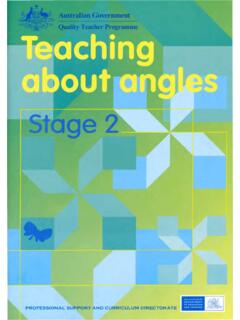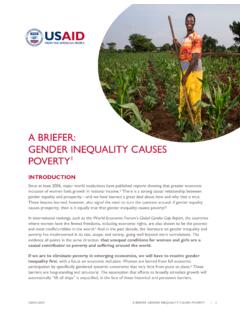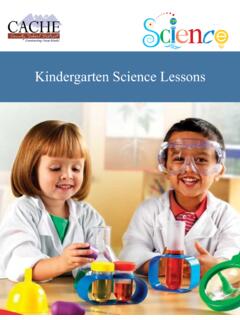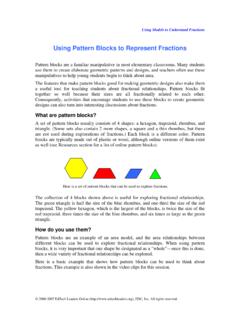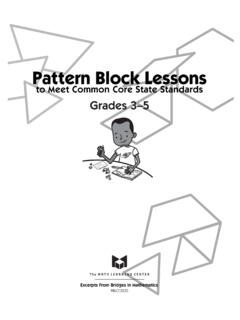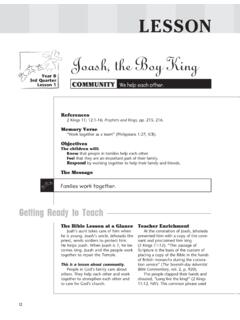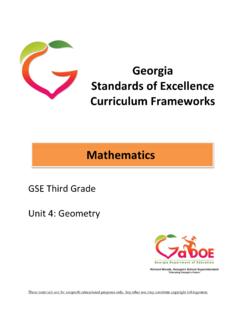Transcription of Light and Sound - Alvord Unified School District
1 Waves: Light and Sound First Grade Next Generation Science Standards TBA ISD June 2013 Created by: Sue Bishop, Erika Olvey and Annie Grammer Teacher Introduction to Waves: Light and Sound During the study of Light and Sound waves students will develop their science skills through inquiry, prediction, observation, exploration, discussion and recording. These lessons focus on students collaboratively problem solving, discovering and investigating to find answers and solutions. They will answer questions such as; What happens when materials vibrate? What objects can be used to communicate over a distance? What happens when Light is blocked or when materials of different kinds are placed in the path of a beam of Light ? Each lesson includes science and engineering practices, disciplinary core ideas and crosscutting concepts which are a part of Next Generation Science Standards.
2 These lessons were designed to allow students to make their own predictions and observations while testing and recording their findings. Our lessons were planned using the 5-E Learning Cycle Model. Each lesson is broken down into the following categories; Engage, Explore, Explain, Extend and Evaluate. We also chose to break the lessons into sessions. Some lessons may take 1-2 thirty minute sessions. We included suggestions as to how we would break those lessons; please use these lessons as they fit into your schedule. Each lesson contains pertinent information to assure that all of the standards are addressed. Student journal pages are included after each lesson . There are 3 performance assessments included in the student journal. Make sure to keep the student journals until those have been recorded on the final assessment page. : Light and Sound *The performance expectations marked with an asterisk integrate traditional science content with engineering through a Practice or Disciplinary Core Idea.
3 The section entitled Disciplinary Core Ideas is reproduced verbatim from A Framework for K-12 Science Education: Practices, Cross-Cutting Concepts, and Core Ideas. Integrated and reprinted with permission from the National Academy of Sciences. : Light and Sound Students who demonstrate understanding can: 1-PS4-1. Plan and conduct investigations to provide evidence that vibrating materials can make Sound and that Sound can make materials vibrate. [Clarification Statement: Examples of vibrating materials that make Sound could include tuning forks and plucking a stretched string. Examples of how Sound can make matter vibrate could include holding a piece of paper near a speaker making Sound and holding an object near a vibrating tuning fork.] 1-PS4-2. Make observations to construct an evidence-based account that objects can be seen only when illuminated. [Clarification Statement: Examples of observations could include those made in a completely dark room, a pinhole box, and a video of a cave explorer with a flashlight.]
4 Illumination could be from an external Light source or by an object giving off its own Light .] 1-PS4-3. Plan and conduct an investigation to determine the effect of placing objects made with different materials in the path of a beam of Light . [Clarification Statement: Examples of materials could include those that are transparent (such as clear plastic), translucent (such as wax paper), opaque (such as cardboard), and reflective (such as a mirror).] [Assessment Boundary: Assessment does not include the speed of Light .] 1-PS4-4. Use tools and materials to design and build a device that uses Light or Sound to solve the problem of communicating over a distance.* [Clarification Statement: Examples of devices could include a Light source to send signals, paper cup and string telephones, and a pattern of drum beats.] [Assessment Boundary: Assessment does not include technological details for how communication devices work.
5 ] The performance expectations above were developed using the following elements from the NRC document A Framework for K-12 Science Education: Science and Engineering Practices Planning and Carrying Out Investigations Planning and carrying out investigations to answer questions or test solutions to problems in K 2 builds on prior experiences and progresses to simple investigations, based on fair tests, which provide data to support explanations or design solutions. Plan and conduct investigations collaboratively to produce data to serve as the basis for evidence to answer a question. (1-PS4-1),(1-PS4-3) Constructing Explanations and Designing Solutions Constructing explanations and designing solutions in K 2 builds on prior experiences and progresses to the use of evidence and ideas in constructing evidence-based accounts of natural phenomena and designing solutions. Make observations (firsthand or from media) to construct an evidence-based account for natural phenomena (1-PS4-2) Use tools and materials provided to design a device that solves a specific problem.
6 (1-PS4-4) ---------------------------------------- ---------------- Connections to Nature of Science Scientific Investigations Use a Variety of Methods Science investigations begin with a question. (1-PS4-1) Scientists use different ways to study the world. (1-PS4-1) Disciplinary Core Ideas : Wave Properties Sound can make matter vibrate, and vibrating matter can make Sound . (1-PS4-1) : Electromagnetic Radiation Objects can be seen if Light is available to illuminate them or if they give off their own Light . (1-PS4-2) Some materials allow Light to pass through them, others allow only some Light through and others block all the Light and create a dark shadow on any surface beyond them, where the Light cannot reach. Mirrors can be used to redirect a Light beam. (Boundary: The idea that Light travels from place to place is developed through experiences with Light sources, mirrors, and shadows, but no attempt is made to discuss the speed of Light .)
7 (1-PS4-3) : Information Technologies and Instrumentation People also use a variety of devices to communicate (send and receive information) over long distances. (1-PS4-4) Crosscutting Concepts Cause and Effect Simple tests can be designed to gather evidence to support or refute student ideas about causes. (1-PS4-1),(1-PS4-2),(1-PS4-3) ---------------------------------------- ---------Connections to Engineering, Technology, and Applications of Science Influence of Engineering, Technology, and Science, on Society and the Natural World People depend on various technologies in their lives; human life would be very different without technology. (1-PS4-4) Connections to other DCIs in first grade: N/A Articulation of DCIs across grade-levels: (1-PS4-4); (1-PS4-3); (1-PS4-4); (1-PS4-4); (1-PS4-2); (1-PS4-4) Common Core State Standards Connections: ELA/Literacy Write informative/explanatory texts in which they name a topic, supply some facts about the topic, and provide some sense of closure.
8 (1-PS4-2) Participate in shared research and writing projects ( , explore a number of how-to books on a given topic and use them to write a sequence of instructions). (1-PS4-1),(1-PS4-2),(1-PS4-3),(1-PS4-4) With guidance and support from adults, recall information from experiences or gather information from provided sources to answer a question. (1-PS4-1),(1-PS4-2),(1-PS4-3) Participate in collaborative conversations with diverse partners about grade 1 topics and texts with peers and adults in small and larger groups. (1-PS4-1),(1-PS4-2),(1-PS4-3) Mathematics Use appropriate tools strategically. (1-PS4-4) Order three objects by length; compare the lengths of two objects indirectly by using a third object. (1-PS4-4) Express the length of an object as a whole number of length units, by layering multiple copies of a shorter object (the length unit) end to end; understand that the length measurement of an object is the number of same-size length units that span it with no gaps or overlaps.
9 (1-PS4-4) May 2013 NGSS Release9 Dear Family, Our class is starting to learn about Sound and Light . My teacher said we re going to be exploring and experimenting with a lot of fun stuff. We get to be scientists! These are the main ideas of our unit. - Sounds are made when something vibrates - Sounds can be loud or soft and high or low - We use Sound and Light to communicate - A shadow is made when something blocks the Light . These are a few of our new vocabulary words. - Translucent - Transparent - Opaque - Reflective - Illumination - Vibration - Communication Here are a few fun ways you can help me at home. - We can put out different sized cooking pans and use spoons to tap on them to hear different sounds. - We can use a few of the same size drinking glasses and fill them with different amounts of water. Then we lightly tap on them and listen to the different sounds they make.
10 - Using a flashlight or lamp we can shine it against a blank wall and put different objects in front of it to make shadows. There are also a couple of good books that we can get from the library. ZIN! ZIN! ZIN! A Violin by Lloyd Moss What Makes a Shadow? by Clyde Robert Bulla One more thing.. I need to bring a toilet paper tube for one of our first activities. Thanks for helping me be a great student! lesson 1* Focus: 5 Senses Length: 1- 30 minute session Materials: - My Five Senses by Aliki - Student Journal cover and pg. 1 Student Grouping/Class Set Up: Whole Group Engage: Read the book My Five Senses aloud to the class. Then explain that they will complete the student journal page. They need to draw and label two examples of each of the five senses. Explore: As students finish their first journal page they can discuss their drawings and explore the journal with their friends.


